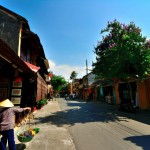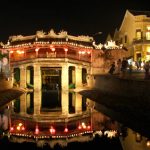Hoi An Ancient Town An Ancient Beauty Of Viet Nam
The moment you enter the city, the mystique of a secluded ancient town, isolated from the modern world, will make you feel you have travelled back in time, to the old countryside society of Vietnam.
Hoi An is a small town in Central Vietnam, on the coast of the East Sea. Located at the estuary of the Thu Bon river, Hoi An was a busy international commercial port in the 16th and 17th centuries. People from Japan, Holland, India and various Chinese provinces settled down here during the same period. Today Hoi An stands as an example of ancient architecture, and was declared a World Heritage by UNESCO for being one of the best preserved ancient Southeast Asian trading ports.
Hoi An is one of Vietnam’s most popular tourist attractions. It lures the tourists in Vietnam, with the charming ancient temples, shrines, Chinese style tile-roofed wooden houses and a unique blend of Japanese and Chinese architecture. Its buildings and its street plan reflect the indigenous and foreign influences that have combined to produce this unique heritage site. Hoi An was also known by a variety of monikers, FaiFo and HaiFo (in the 16th century) being the most common ones. The town has long been a cultural crossroad, and it emerged when Japanese and Chinese traders built a commercial district here.

What is so special about Hoi An is that this little port town is in an incredible state of preservation. It offers some of the most densely concentrated sights in Vietnam, with its old streets bordered with ancient houses and assembly halls, with its pagodas, temples, ancient wells and tombs. The architecture of Hoi An is characterized by a harmonious blend of Vietnamese, Chinese and Japanese influences. After many centuries, Hoi An is still respectful of its traditions, folk festivals, beliefs and sophisticated culinary art. Many of these buildings have been preserved in their original forms, making it easier to imagine the trading town’s former prosperity and glory. The houses are small and colourful, with wooden doors and two round “wooden house’s eyes” above, window shutters and ornamental furniture. All the houses are made of rare wood, decorated with lacquered boards and panels engraved with Chinese characters. A walking tour is the best way to see the the Japanese-covered Bridge, the wonderful market and the wooden-fronted houses that once belonged to the town’s prosperous merchants.haancientbeauty3
What is so special about Hoi An is that this little port town is in an incredible state of preservation. It offers some of the most densely concentrated sights in Vietnam, with its old streets bordered with ancient houses and assembly halls, with its pagodas, temples, ancient wells and tombs. The architecture of Hoi An is characterized by a harmonious blend of Vietnamese, Chinese and Japanese influences. After many centuries, Hoi An is still respectful of its traditions, folk festivals, beliefs and sophisticated culinary art. Many of these buildings have been preserved in their original forms, making it easier to imagine the trading town’s former prosperity and glory. The houses are small and colourful, with wooden doors and two round “wooden house’s eyes” above, window shutters and ornamental furniture. All the houses are made of rare wood, decorated with lacquered boards and panels engraved with Chinese characters. A walking tour is the best way to see the the Japanese-covered Bridge, the wonderful market and the wooden-fronted houses that once belonged to the town’s prosperous merchants.
Set in a quiet environhaancientbeauty4ment, Hoi An is surrounded by peaceful villages, a beautiful river, and the Cua Dai Beach, merely five kilometres from the centre. Locals and visitors alike come here for its sandy beach, warm sea and seafood stalls. Hoi An is known throughout Vietnam for its excellent seafood, and it also boasts with its own unique dishes such as Cao Lau, a delicious combination of noodles, pork, bean sprouts, mint and croutons. Offshore, Cham Islands are very famous for sheltering their prized birds’ nests. Hoi An is also well known as a shopping paradise that attracts you towards its wonderful souvenirs, craft handiworks, antique pieces, silk materials and art paintings that you just cannot miss out on!
Inland and a half-day trip from Hoi An is My Son, where the capital of the once great Champa Kingdom stood between the 2nd and 15th centuries. The Cham Museum, housed in a classical French colonial building in Danang, has the finest collection of Cham sculpture in the world, much of it originating from the My Son site.
Right on Danang’s doorstep is Non Nuoc Beach, with its miles of golden sand beaches and home to a luxurious beach resort complex. Another popular site in the Danang area is that of the Marble Mountains, five sacred marble and limestone hills. Many shrines and temples have been constructed over the centuries both on the hillsides and in the spectacular natural caves concealed within the hills.
A vacation in Hoi An is ideal for those looking for a break from the busy city life, those longing for peace and tranquility in beautiful surroundings.
Soure: hoian-tourism.com
Post Views:
2,701








